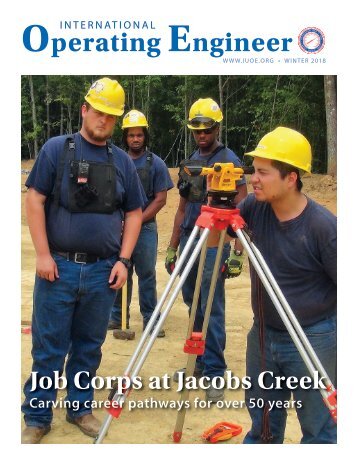International Operating Engineer - Summer 2016
- Text
- Operating
- Iuoe
- Trump
- Veterans
- Engineer
- Zika
- Engineers
- Osha
- Workers
- Aedes
Safety & Health Zika
Safety & Health Zika Virus and Working Outdoors this Summer THE OCCUPATIONAL SAFETY AND HEALTH ADMINISTRATION (OSHA) and the National Institute for Occupational Safety and Health (NIOSH) are monitoring the Zika virus outbreak and have issued an Interim Guidance for Protecting Workers from Occupational Exposure to Zika Virus. Zika virus is primarily spread through the bites of infected mosquitoes. Mosquitoes can become infected when they bite infected persons and can then spread the Zika virus to other persons they bite. Aedes species mosquitoes are the principal carriers of Zika virus in the United States. Aedes aegypti (yellow fever mosquitoes) are typically concentrated in the southern U.S. as well as parts of the Southwest (see map). Aedes albopictus (Asian Tiger mosquitoes) are found in much of the southern and eastern part of the U.S. (see map). In some instances, having contact with infectious blood or other bodily fluids of an infected person can result in transmission of the Zika virus as well. Approximately one out of five infected people develop symptoms of the Zika virus, usually 2-7 days after exposure. Symptoms are usually mild and can last 2-7 days. The most common symptoms of Zika virus are fever, rash, joint pain, red or pink eyes, muscle pain, and headache. You may have also heard that the Zika virus has been found to cause neurological problems in adults. The Brazil Ministry of Health has reported an increased number of people who have been infected with Zika virus who also have Guillain-Barre Syndrome (GBS). GBS is an uncommon sickness of the nervous system in which a person’s own immune system damages the nerve cells, causing muscle weakness, and sometimes, paralysis. The Center for Disease Control (CDC) is investigating the link between Zika and GBS. Outdoor workers, those doing mosquito control, healthcare workers, and others with potential exposure to bloodborne pathogens may be exposed to the Zika virus. However, because outdoor workers may be at the greatest risk of exposure to the virus, OSHA along with NIOSH have developed recommendations for protecting them from exposure. These recommendations include the following: • Use insect repellants. • Wear clothing that covers hands, arms, legs and other exposed skin. Wear hats with mosquito netting to protect the face and neck. Wear socks/boots that cover the ankles and lower legs. • In warm weather, wear lightweight, loose-fitting clothing. • Get rid of sources of standing water (e.g. tires, buckets, cans, bottles, barrels) whenever possible to reduce or eliminate mosquito breeding areas. • For females who are or may become pregnant or males who partners are or may become pregnant, talk to your supervisor about your outdoor work assignments. • If symptoms develop, seek medical attention promptly. Discuss any possible exposure to mosquitoes or infections spread by mosquitoes with a healthcare provider. You have to take into consideration the recommendation along with the type of work you are doing to make sure the recommendation itself does not create a hazardous work condition. For example wearing loosefitting clothing if it could be caught in moving parts on a piece of heavy equipment. Heat stress must also be taken into consideration when wearing clothing that will cover exposed skin during warm/hot weather. CDC’s Response to Zika ESTIMATED range of Aedes albopictus and Aedes aegypti in the United States, 2016* CA CA HI CS264451-F OR OR HI WA NV WA NV ID AZ ID AZ UT UT PR PR MT WY CO NM MT WY CO NM ND SD NE TX KS KS OK Aedes aegypti ND SD NE TX OK MN MN IA IA MO AR LA MO AR LA WI WI IL MS IL MS IN AL IN MI TN AL MI TN KY KY OH GA OH GA WV WV SC FL SC FL PA VA NC Aedes albopictus PA VA NC NY NY VT NH MA RI CT NJ DE MD ME VT NH MA RI CT NJ DE * Maps have been updated from a variety of sources. These maps represent CDC’s best estimate of the potential range of Aedes aegypti and Aedes albopictus in the United States. Maps are not meant to represent risk for spread of disease. MD ME Aedes aegypti mosquitoes are more likely to spread viruses like Zika, dengue, chikungunya and other viruses than other types of mosquitoes such as Aedes albopictus mosquitoes. These maps DO NOT show · Exact locations or numbers of mosquitoes living in an area · Risk or likelihood that these mosquitoes will spread viruses These maps show · CDC’s best estimate of the potential range of Aedes aegypti and Aedes albopictus in the United States · Areas where mosquitoes are or have been previously found 8 INTERNATIONAL OPERATING ENGINEER SUMMER 2016 9
- Page 1 and 2: i n t e r n at i o n a l Operating
- Page 4: International Operating Engineer (I
- Page 10: Healthcare The Doctor is Now In, Do
- Page 14: Feature “He served in Vietnam, ha
- Page 18: Canadian News Ontario Apprentices G
- Page 22: POLITICS In June 2016, Limon told C
- Page 26: International Union of Operating En
Inappropriate
Loading...
Mail this publication
Loading...
Embed
Loading...
International Operating Engineer
HEADQUARTERS
INTERNATIONAL UNION OF OPERATING ENGINEERS (IUOE)
1125 17th Street, NW
Washington, DC 20036
202 429-9100
CONTACT US
Send us an email here.
©2010 International Union of Operating Engineers. All Rights Reserved.|Terms Of Use|Privacy Statement|Sitemap



















